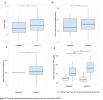Hyperbaric oxygen therapy improves clinical symptoms and functional capacity and restores thalamic connectivity in ME/CFS
BACKGROUND
Myalgic encephalomyelitis/chronic fatigue syndrome (ME/CFS) is a debilitating disorder characterized by profound fatigue, cognitive impairment, autonomic dysfunction, and exertional intolerance with strongly impaired physical functioning. Hyperbaric oxygen therapy (HBOT) has been proposed as a potential treatment, but its effects on ME/CFS patients remain largely unexplored. This study aimed to evaluate the effectiveness and feasibility of HBOT in ME/CFS patients and to investigate its effects on functional brain changes.
METHODS
30 ME/CFS patients (mean age: 42.3 ± 11.7 years; seven males, 23 females) received 40 HBOT sessions each. Outcomes were assessed at baseline, during treatment, and four weeks post-treatment. The primary outcome was change in the Physical Functioning subscale of the Short Form-36 Health Survey (SF-36 PF). Secondary outcomes included severity of core symptoms assessed via questionnaires, exercise capacity, handgrip strength, cognitive performance, orthostatic intolerance, and brain MRI (volumetry and functional connectivity, (FC)). Thirty age-and sex-matched healthy controls (HCs) (mean age: 42.3 ± 11.3 years; seven males, 23 females) were included for MRI comparison.
FINDINGS
In the linear mixed model, SF-36 PF significantly improved during HBOT compared with baseline (g = 0.71, p = 0.006). SF36 pain (p = 0.002, g = 0.79) and CFQ fatigue showed clinically meaningful reductions (p < 0.001, g = -0.87) during HBOT. Exercise capacity (g = 0.66), muscle strength (g = 0.40), and information processing speed (g = 0.52), all improved significantly after HBOT compared to baseline (all p < 0.05). Treatment adherence was high, and tolerability was favorable, with no major side effects reported. Functional MRI analyses revealed increased thalamic FC in ME/CFS patients compared to HCs in bilateral sensorimotor (p < 0.001, t = 5.65, FDR-corrected) and visuo-occipital regions (p < 0.001, t = 5.4, FDR-corrected) at baseline. After HBOT, thalamic hyperconnectivity normalized. Responders (defined as a ≥ 10 point increase in SF-36 PF) showed greater reductions in thalamic hyperconnectivity than non-responders (p < 0.001, t = -4.34 to -5.18, FDR-corrected).
INTERPRETATION
HBOT was well-tolerated and was associated with significant improvements in physical functioning, fatigue, pain, and cognitive performance and provides the rationale for a controlled trial in ME/CFS to confirm therapeutic efficacy. The normalization of thalamic hyperconnectivity following HBOT and its association with clinical response highlights the role of thalamic FC in ME/CFS pathophysiology and underscores the need for larger, controlled trials in ME/CFS to confirm therapeutic efficacy.
FUNDING
Funded by The Federal Ministry of Education and Research (NKSG, 01EP2201), the Klinik Bavaria Kreischa, and the Weidenhammer Zoebele Research Foundation.
Web | PDF | Preprint: MedRxiv | Open Access
Laura Kim; Guido Cammà; Claudia Kedor Peters; Maron Mantwill; Oliver Müller; Nadège Leprêtre; Cornelia Heindrich; Rebekka Rust; Moritz Krill; Tim J Hartung; Lukas Reeß; Stephan Krohn; Christian von Heymann; Kirsten Wittke; Carsten Finke; Carmen Scheibenbogen
BACKGROUND
Myalgic encephalomyelitis/chronic fatigue syndrome (ME/CFS) is a debilitating disorder characterized by profound fatigue, cognitive impairment, autonomic dysfunction, and exertional intolerance with strongly impaired physical functioning. Hyperbaric oxygen therapy (HBOT) has been proposed as a potential treatment, but its effects on ME/CFS patients remain largely unexplored. This study aimed to evaluate the effectiveness and feasibility of HBOT in ME/CFS patients and to investigate its effects on functional brain changes.
METHODS
30 ME/CFS patients (mean age: 42.3 ± 11.7 years; seven males, 23 females) received 40 HBOT sessions each. Outcomes were assessed at baseline, during treatment, and four weeks post-treatment. The primary outcome was change in the Physical Functioning subscale of the Short Form-36 Health Survey (SF-36 PF). Secondary outcomes included severity of core symptoms assessed via questionnaires, exercise capacity, handgrip strength, cognitive performance, orthostatic intolerance, and brain MRI (volumetry and functional connectivity, (FC)). Thirty age-and sex-matched healthy controls (HCs) (mean age: 42.3 ± 11.3 years; seven males, 23 females) were included for MRI comparison.
FINDINGS
In the linear mixed model, SF-36 PF significantly improved during HBOT compared with baseline (g = 0.71, p = 0.006). SF36 pain (p = 0.002, g = 0.79) and CFQ fatigue showed clinically meaningful reductions (p < 0.001, g = -0.87) during HBOT. Exercise capacity (g = 0.66), muscle strength (g = 0.40), and information processing speed (g = 0.52), all improved significantly after HBOT compared to baseline (all p < 0.05). Treatment adherence was high, and tolerability was favorable, with no major side effects reported. Functional MRI analyses revealed increased thalamic FC in ME/CFS patients compared to HCs in bilateral sensorimotor (p < 0.001, t = 5.65, FDR-corrected) and visuo-occipital regions (p < 0.001, t = 5.4, FDR-corrected) at baseline. After HBOT, thalamic hyperconnectivity normalized. Responders (defined as a ≥ 10 point increase in SF-36 PF) showed greater reductions in thalamic hyperconnectivity than non-responders (p < 0.001, t = -4.34 to -5.18, FDR-corrected).
INTERPRETATION
HBOT was well-tolerated and was associated with significant improvements in physical functioning, fatigue, pain, and cognitive performance and provides the rationale for a controlled trial in ME/CFS to confirm therapeutic efficacy. The normalization of thalamic hyperconnectivity following HBOT and its association with clinical response highlights the role of thalamic FC in ME/CFS pathophysiology and underscores the need for larger, controlled trials in ME/CFS to confirm therapeutic efficacy.
FUNDING
Funded by The Federal Ministry of Education and Research (NKSG, 01EP2201), the Klinik Bavaria Kreischa, and the Weidenhammer Zoebele Research Foundation.
Web | PDF | Preprint: MedRxiv | Open Access


